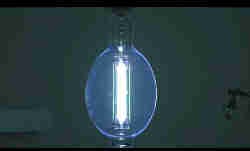Halogen Cycle
- The process of tungsten particles that leave the tungsten filament of halogen bulb reacting with a halogen gas. During this process these tungsten particles combine with halogen gas molecules to form a new compound. This reaction requires high pressure and temperature and thus occurs in the zones inside the capsule where the temperature is sufficiently high such as nearest the filament. Then, upon cooling sufficiently while in an area of the capsule away from the filament, the newly formed compound separates. This separation is in a separate reaction which releases energy in the form of heat and thus both fuels the halogen cycle and serves to further warm the filament.
- Bromine and iodine are the only halogens used in tungsten halogen bulbs with iodine being the more common of the two. They are in a liquid form at lower temperatures but vaporize as the temperature increases. Iodine vaporizes at 184C (363F) and Bromine at 59C (138F).
Halogen IR Bulb
See See Tungsten Halogen Bulb.
Harmonic Distortion
Harmonics
"Harmonic voltages and currents in an electric power system are a result of non-linear electric loads. Harmonic frequencies in the power grid are a frequent cause of power quality problems. Harmonics in power systems result in increased heating in the equipment and conductors, misfiring in variable speed drives, and torque pulsations in motors. Reduction of harmonics is considered desirable." - Wikipedia
Harp
The part of a table lamp that holds the lamp shade.
Hazardous Location
Locations (applications) where explosive/combustible materials/substances are present in hazardous amounts. These locations are broken down by the National Fire Protection Association (NFPA) into two classes, class 1 - gases/liquids and class 2 - dust. These locations require special fixtures designed to prevent heat and/or electric arcs from interacting with the surrounding environment.
Heat Shield
A type of device added to certain bulbs in order to shield the base from the heat generated by the bulb and/or the application. Heat shields can come in ceramic, metallic and in rare cases transparent infrared reflecting versions.
Helix Shape
The DAMAR® name for a bulb shaped like a spiral. These are also sometimes (*incorrectly*) called pig tail, corkscrew, curly-q, twist/twisted, curled and spun.
Hertz
Abbreviated as "Hz". The SI standard unit of frequency. Describes the cycles per second for current or voltage.
HID
High Bay
See Fixture (Lighting).
High Frequency Operation
"Refers to the operation of electronic ballasts as frequencies between 25 and 60 KiloHertz (KHz) - 25,000 to 60,000 cycles per second." - Advance Ballast Glossary
High Intensity Discharge Bulb
- Abbreviated as "HID". An electric gas discharge bulb that emits light generated by an electric arc established between electrodes within a translucent capsule called an arc tube. Gas and metal compounds are placed inside the arc tube which that facilitate the establishment of the arc, increase the efficacy of the emissions and even alter the color of the bulb's output. There are many different HID technologies manufactured. A few are listed here: Low Pressure Sodium, High Pressure Sodium, Xenon Short-arc, Mercury Vapor and Metal Halide in Probe Start, Pulse Start and Ceramic.
-
Low Pressure Sodium Bulb (LPS)
-
High Pressure Sodium Bulb (HPS)
-
Mercury Vapor Bulb (MV)
-
Metal Halide Bulb (MH)
-
Probe Start
The traditional starting method for Metal Halide bulbs. The arc tube of a probe start Metal Halide bulb includes three electrodes. In order to start the bulb a small arc is established between the starting electrode and the operating electrode which are located at the bottom of the arc tube (the end nearest the base). Once the arc tube's gas fill is sufficiently ionized electrons can begin to jump between the two operating electrodes. Once started the starting electrode is automatically switched off from within the bulb. This technology was succeeded by Pulse Start technology. -
Pulse Start (/PS)
The name for both the start method of "Pulse-start Metal Halide" (PS) bulbs and the bulbs themselves. The primary differences between PS and standard Probe Start Metal Halide bulbs are
- Pulse Start bulbs do not use or have a starting probe electrode like Probe Start bulbs.
- Pulse start bulbs require a component called an ignitor that in concert with the ballast provides high-voltage pulses of more than 3 but generally less than 6 kilovolts to start the bulb.
- The arc tubes of Pulse Start bulbs have a smaller pinch seal than those of Probe Start bulbs resulting in less heat loss.
- The Pulse starting method reduces the amount of tungsten deposited on the wall of the arc tube which over time results in a far superior lumen maintenance over Probe Start bulbs.
- The time to full brightness or "warm-up time" is significantly reduced in Pulse Start bulbs.
-
Ceramic (MHC, MCP, CMH)
-
High Power Factor Ballast
See Power Factor.
High Pressure Sodium Bulb
Abbreviated as "HPS". Its ANSI designation is "S". See High Pressure Sodium Bulb.
Hood
See Cutoff.
Hook Mount
Horizontal
See Operating Position.
Horticultural Lighting
See Fixture (Lighting).

